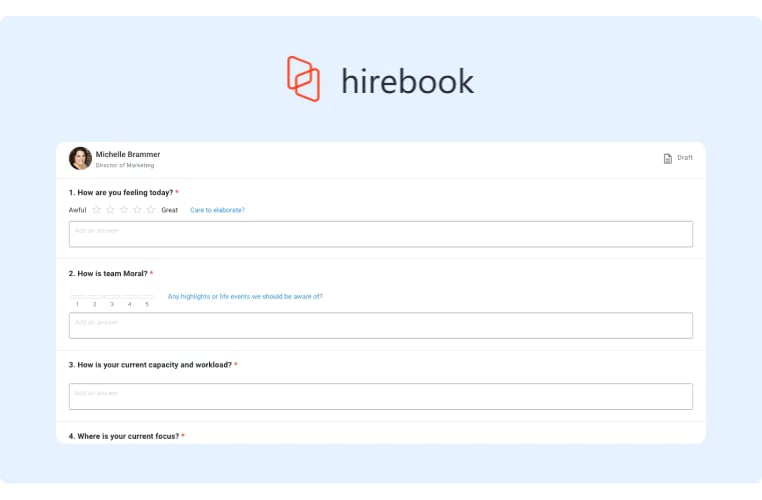How To Build Unshakable Employee Morale in Five Steps
Many HR managers try to boost employee morale by offering more perks, like gym memberships, free snacks, and allowances. However, more perks rarely correlate with higher employee morale, as the root cause of poor employee morale usually stems from weak company culture.
Unfortunately, throwing perks on top of a weak cultural foundation won’t solve the root of the problem.
It’s also worth noting that external factors, like layoff fears, can trigger low employee morale.
So, even if the company doesn’t have a toxic culture, a neutral culture that was previously sufficient to keep employees motivated during times of prosperity might not be sufficient to rally employees during challenges.
To help you keep employee morale high through challenging times, we’ll discuss building a strong cultural foundation that inspires employees and five strategies to improve employee morale.
Foundational Pillars for Strong Employee Morale
If you can build an inspiring culture, high employee morale and other benefits like low turnover rates, improved productivity, and higher employee satisfaction are positive side effects. Here are four pillars to build that culture.
1. Regularly Measure Employee Morale
Measure employee morale before making changes so you can see if the changes you implement are effective and adjust your strategy objectively.
You can measure morale by surveying employees and asking questions like:
- How excited are you about your current role?
- How optimistic do you feel about the future of the company?
- Do you feel that you’re making an impact on the world in your current role?
- Do you feel appreciated at work?
For employees that scored low on the original employee morale survey, ask follow-up questions about what’s currently dragging them down and causing them to feel unmotivated at work.
Many employees will provide vague responses in open-ended feedback, so you can also ask more specific follow-up questions like:
- Do you feel you have a healthy work-life balance?
- Do you feel your team and manager provide the support necessary to execute your job?
- How comfortable do you feel telling your manager about the challenges you face in your role?
- Do you enjoy the team members you work with daily?
- Do you feel secure in your job?
You can also do one-on-one meetings with team managers every quarter to ask them about general team morale and identify key challenges weighing on their teams.
By adopting a continuous improvement approach to employee morale, you can keep company morale high and identify budding issues before they escalate and cause burnout and employee turnover.

An example of a weekly pulse conducted at GaggleAMP
2. Celebrate Wins and Reward Employee Accomplishments
The best employees are often intrinsically motivated to perform well and don’t need perks to encourage them.
However, celebrating wins and practicing employee recognition is still essential to keeping the team motivated. It can be discouraging to always look at tasks that still need to be done rather than appreciating all that you’ve already accomplished.
Some excellent examples of how you can reward employees for their accomplishments include:
- Monetary rewards (like bonuses).
- Professional development opportunities (like speaking gigs).
- Verbal praise.
- Team parties.

When employees feel appreciated, they’re more likely to have higher morale and a more positive outlook on their job in general.
3. Prioritize Employee Mental Health and Well-Being
Employees that don't feel mentally or physically well probably won't feel motivated, leading to poor workplace morale.
However, most companies don't know how to optimize employee well-being.
For example, the company might offer free healthy snacks or gym memberships, but those initiatives are rarely effective methods to improve employee well-being (including mental health and engagement).
Instead, employee well-being issues often stem from internal issues, like poor communication, excessive work, and tension with co-workers.
As managers tend to have the most impact on their employees' daily work life, the first step to improving employee well-being is achieving buy-in from managers.
You can explain to managers how happy employees are more productive and deliver better work. Then, give managers the tools they need to improve the employee experience. For example, tell them to ask their employees about their well-being in one-on-one meetings regularly. Also pay close attention to team dynamics, as not all employees will speak up when a problem arises.
HR can also help improve employee well-being and morale by running team-building activities and other initiatives that strengthen co-workers' relationships.
4. Create a Compelling Mission
Employees are usually most inspired when they're working on a mission they truly believe is meaningful. One of the best ways to boost employee morale is to strengthen the company mission.
In fact, many companies with the best cultures offer minimal health and wellness initiatives and don't sugarcoat the challenges employees can expect to face. For example, Airbnb actively discourages applicants from joining the team because they tell them they must work hard and go the extra mile in everything they do.
However, Airbnb's vision and mission are so compelling that they still have high employee morale, a productive workplace culture, and continuously attract top talent.
Figure is another example of a company that has cultivated such a strong mission and vision that positive employee morale is essentially baked into the culture. Regardless of what happens in the exterior economy, employee morale will likely remain unshaken within Figure.
Strengthening mission and vision comes from executive leadership, so talk to them to figure out how to build a compelling mission and spread it to the rest of your employees.
Five Strategies To Improve Employee Morale
Now that you have a strong cultural foundation these five strategies are excellent for keeping employee morale high even through the most challenging times.
Strategy 1: Leverage Employee Advocacy
Employee advocacy is a strategy that encourages employees to actively create and publish content related to the brand's mission on social media.
Employees who actively share the company's mission with their friends and colleagues on social media tend to be more invested in the company's success, leading to improved employee morale.
Here's an excellent example of employee advocacy where the CMO of Semrush shares some recent personal and professional achievements:

However, encouraging employees to become active brand advocates on social media can be challenging, especially if your employees don't normally post on social media.
To make it easier to encourage employee advocacy, consider using an employee advocacy tool like GaggleAMP. It allows you to create and assign personalized engagement activities at scale.
For example, if the company recently launched a new product, you can create an engagement activity for everyone on the sales team that requests they create and publish a post about the new product.
Your employees receive a notification when you assign the activity, and they can log into their personal dashboard to complete the request.

You'll also have access to detailed employee engagement and content analytics, making it easy to track your employee advocacy efforts.
To learn more about how the platform works, you can explore the features page or schedule a demo.
Strategy 2: Host Company Offsites
Company offsites are a highly effective strategy to boost employee morale as it helps employees connect on a deeper level and realize they're part of a larger mission.
This is especially true for remote teams where employees might feel alone and detached from their co-workers during weeks of solitary workdays.
During company offsites, you can do team-building exercises, discuss challenges, and gather more qualitative employee feedback to improve employee morale.
If you need help managing your company offsite, you can use a service like the The Offsite Co. to handle the process.
Strategy 3: Offer Coaching and Mentorship
Offering access to coaches and mentors is an excellent way to boost employee morale. They can cheer employees through challenging times and, perhaps more importantly, help them build the skill sets necessary to navigate challenges.
Once employees conquer one challenge, it will boost their confidence and help them feel more encouraged when tackling the next challenge. When employees are more successful, they also report higher job satisfaction and are generally happier.
In addition, having a mentor or coach to talk to will make your employees feel more supported as they're no longer facing each challenge alone. This mindset shift alone is powerful and often enough to significantly boost morale.
Finally, offering coaching and mentorship is a great recruiting strategy, as the best employees often value growth more than salary or time off.
To provide coaching resources, you can ask managers to schedule one-on-one coaching sessions with junior-level employees. Alternatively, you can create a budget for each employee to do coaching calls on a platform like Intro or Clarity.
Another option is to hire an executive coach for a day to come into your office and do a leadership coaching session.
Strategy 4: Celebrate Company Milestones/Achievements
Great employees often focus on solving challenges and forget to recognize the accomplishments they've achieved.
However, if they pause and recognize their accomplishments, it will give them renewed faith and confidence to tackle the next challenge more effectively.
Make a point to celebrate recent achievements, like a new closing round of funding, hitting a new sales goal, or a successful product launch.

These celebrations can be as simple as a thoughtful note from the executive team or hosting a pizza party (you can use a tool like Pizzatime.xyz if you're remote). To make this tip effective, talk to your leadership team and encourage them to celebrate wins, as employees likely won't celebrate if they notice that executives don't celebrate.
Strategy 5: Actively Encourage Employee Feedback and Communication
Sometimes the best solution to improve morale is simply talking about challenges draining your employees.
Whether it's the declining economy or missed sales goals, giving employees a safe space to voice their concerns is a great way to quickly get to the root problem. Sometimes an honest, transparent conversation is all employees need to dispel worries hampering employee morale.
Work with your managers to create time during one-on-one meetings to discuss morale issues and then use that feedback to make changes accordingly.
Building an Engaged Team That Keeps Employee Morale Strong
Strong employee morale doesn’t come from just offering employees different perks.
It stems from a work environment that prioritizes teamwork, camaraderie, and the greater company mission.
Once you’ve built a culture with this mentality, your team will continue to push through any of the challenges that come their way.
If you’d like to learn how to build a work culture of employee advocacy, consider exploring GaggleAMP’s features or schedule a demo of it today.








